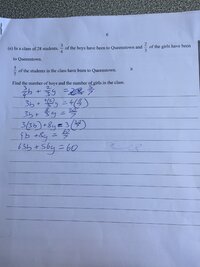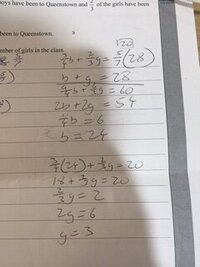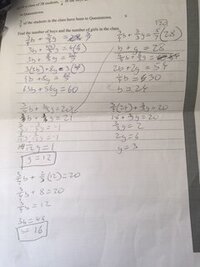You are using an out of date browser. It may not display this or other websites correctly.
You should upgrade or use an alternative browser.
You should upgrade or use an alternative browser.
In a class of 28 students, 3/4 of the boys have been to Queenstown and...
- Thread starter BanaMath
- Start date
- Joined
- Feb 4, 2004
- Messages
- 16,550
I'm kinda stuck on this problem. What should I do now?
Picture below.
Thanks!
Hint: The sum of the number of boys who've visited and the number of girls who've visited is not "5/7" (since this would represent a fractional person), but is "5/7 of 28".
Harry_the_cat
Elite Member
- Joined
- Mar 16, 2016
- Messages
- 3,779
That will give you one equation with two variables. To solve for b and g, you need another equation and then you need to solve simultaneously.Hint: The sum of the number of boys who've visited and the number of girls who've visited is not "5/7" (since this would represent a fractional person), but is "5/7 of 28".
Hint: What does b + g equal ?
Steven G
Elite Member
- Joined
- Dec 30, 2014
- Messages
- 14,603
OK, your 1st equation, which you simplified correctly, is wrong. The point I am trying to make is that you have one equation with two variables, so you need to try to get a 2nd equation. Did you try to get a 2nd equation but couldn't? Whenever you have two unknowns you should try to get two equations.
The Highlander
Senior Member
- Joined
- Feb 18, 2022
- Messages
- 1,203
There are 28 students in the class.I'm kinda stuck on this problem. What should I do now?
Picture below.
Thanks!
There are only two sexes (b & g) so the number of boys (b) and the number of girls (g) must add up to 28.
Write that statement as an equation and you will get the the one hinted at by @Harry_the_cat at the end of Post #3 (do follow that link to see exactly what I am referring to).
As has been already stated, you need to have two equations to solve for two variables (b & g).
\(\displaystyle \frac{5}{7}\) of the students in the class have been to Queenstown and there are 28 students in the class, so what is \(\displaystyle \frac{5}{7}\) of that?
Now you know how many students have actually been to Queenstown you can equate that number to \(\displaystyle \frac{3}{4}\) of the boys (¾b) plus \(\displaystyle \frac{2}{3}\) of the girls (⅔g) to get a second equation.
You can now solve these two equations simultaneously to get the values of b &g.
If you don't know (or are unsure about) how to solve simultaneous equations then please study this web page.
If you already are familiar with how to solve simultaneous equations (or have now studied the above web page) then I would advise you to manipulate your first equation (b + g = ) so that the coefficient of one of the variables in it is the same as the coefficient of that variable in your second equation. (eg: Multiply everything in it by ¾ or ⅔.)
Hope that helps. ?
Last edited:
Steven G
Elite Member
- Joined
- Dec 30, 2014
- Messages
- 14,603
You're going to get yourself into trouble one day with that assumption!There are only two sexes (b & g)
- Joined
- Feb 4, 2004
- Messages
- 16,550
There are only two sexes (b & g)...
You're going to get yourself into trouble one day with that assumption!
My understanding is that "sex" and "gender" are not the same. For instance, in my case, "gender" is "hetero female" and "sex" is "not enough". ?
The Highlander
Senior Member
- Joined
- Feb 18, 2022
- Messages
- 1,203
Wasn't an "assumption", it was a statement of fact!You're going to get yourself into trouble one day with that assumption!
"Gender" is a grammatical construct; nouns have "gender", people have (a) sex! (Which is as immutable as the laws of Physics!)
(I'm a totally unreconstructed male from the middle of the last century, I can't help it. ?
The Highlander
Senior Member
- Joined
- Feb 18, 2022
- Messages
- 1,203
The question tells you that the "total number of boys and girls" is 28! Where on earth do you get 27 from???Ok so sorry for the late reply, just been doing a lot of practice exams lately. Based on your advice, I've redone the equation but it is still wrong as the total number of boys and girls I get is 27, not 28. Working below. Thanks!
What is \(\displaystyle \frac{5}{7}\) of 28? (Divide 28 by 7 then multiply that answer by 5, yes?)
Assuming you can work that out correctly, please now go back to (my) Post #6 and follow the (detailed) advice given there.



